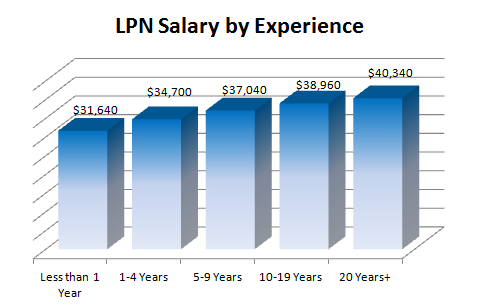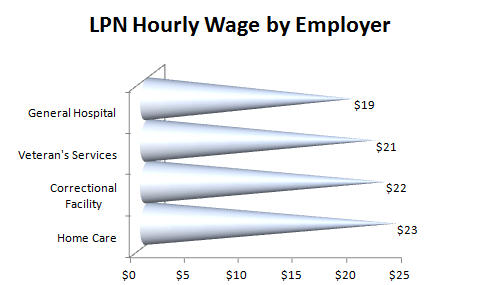According to year-end data compiled by O*Net, the median LPN salary in the United States was $41,802 in 2012. This places the practical nursing profession well above the national average in pay for all positions (this figure was last reported at $33.840 by the U.S. Bureau of Labor Statistics) and represents one of the better salaries available to individuals who have not completed a four-year college degree.
Of course, there are a number of factors that go into determining exactly how much one ultimately earns as a Licensed Practical Nurse. In this guide to LPN salary, we’ll take a detailed look at four of the most-important ones.
Four Things That Determine LPN Salary
As mentioned, the size of any practical nurse’s paycheck is subject to a great many variables. There are, however, four major factors that always play at least some role in determining an LPN’s salary.
Experience
The amount of experience a person has in his or her position will affect pay in virtually every industry, and practical nursing is no exception. As is illustrated by the graph below, the median starting salary for Licensed Practical Nurses is typically just over $31,000 per year, and increases by an average annual rate of almost 4% over the first 10 years of the person’s career.

Source: O*Net
It should be noted, however, that LPN salary tends to peak after 9-10 years in the position and increases more slowly from thereon out. The reason for this is rather obvious when one considers the responsibilities and duties that make-up the standard LPN job description.
For the most part, practical nurses are limited in the duties they may perform, so there is little value added through additional experience after a certain point. Employers often prefer to fill-out their practical nursing staffs with less-tenured individuals who earn lower salaries. It is for this reason that many LPNs decided to become Registered Nurses or other types of nursing professionals after their first several years in the field.
Specialized Certifications
It goes without saying that specialists get paid more than generalists in most professions. In the case of the practical nurse, this is particularly important as certification provides one of the few ways to increase an individual’s earning power while still holding the LPN title.
The certifications that Licensed Practical Nurses pursue allow them to perform a wider range of direct patient care functions than would otherwise be permitted, and are usually related to emergency care. Because all healthcare employers place a premium on employees who can be entrusted to assist patients in emergencies when a physician or RN is not in the room, the most-popular certifications for LPNs are:
- Cardiopulmonary Resuscitation (CPR)
- Basic Life Support (BLS)
- Basic Cardiac Life Support (BCLS)
- Advanced Cardiac Life Support (ACLS)
- Pediatric Advanced Life Support (PALS)
As stated, holding one of these advanced certifications will almost always lead to the LPN earning a higher salary than his or her peers. The following table reflects the average pay increase seen by a practical nurse with each certification when compared against an LPN who does not hold the same certificate.

Source: O*Net
Employer Type
A third factor that plays a major role in determining LPN salary is the type of employer that one works for. While the vast majority of practical nurses are employed by hospitals, an increasing number are finding work with assisted living facilities and other senior care-focused employers. There is also a trend over the past decade where more and more government-sponsored health agencies (e.g. the Veteran’s Administration) have begun to employ LPNs to assist with the care of disabled war veterans. Needless to say, the pay offered by each of these different types of employers can vary.
The following graphic compares the average LPN hourly wage reported by Glassdoor.com in 2012 for practical nurses employed by several different types of employers. While this sample size is admittedly small, it does illustrate the typical variation one finds when working as a Licensed Practical Nurse in distinct settings.

Source: O*NET
Geography
The final variable that usually goes a long way toward determining a practical nurse’s pay is the state and city where he or she works. In general, wages paid to healthcare providers tend to be significantly higher in the Northeast and West Coast than in other parts of the U.S., and professionals who work in cities are almost universally compensated at a higher rate than their rural and suburban counterparts.
To see a complete breakdown of LPN salary by state, be sure to check out our full report on this topic for 2013.
Outlook for LPN Pay
As a whole, the healthcare industry is expected to see its wages and salaries increase by 27% through the end of 2014 (www.forbes.com). Where LPNs are concerned, the outlook is quite good as well, despite the growing preference among some employers to hire CNAs (Certified Nursing Assistants) as a low-cost alternative to Licensed Practical Nurses.
The average LPN salary continues to grow faster than the national average at just over 3.5% per year and the push for current practical nurses to carry more certifications will only cause this rate to go higher. This focus on continuing education has not only created a higher demand for LPN to RN bridge programs, but many other types of online certification courses as well.
What Determines LPN Salary?
According to year-end data compiled by O*Net, the median LPN salary in the United States was $41,802 in 2012. This places the practical nursing profession well above the national average in pay for all positions (this figure was last reported at $33.840 by the U.S. Bureau of Labor Statistics) and represents one of the better salaries available to individuals who have not completed a four-year college degree.
Of course, there are a number of factors that go into determining exactly how much one ultimately earns as a Licensed Practical Nurse. In this guide to LPN salary, we’ll take a detailed look at four of the most-important ones.
Four Things That Determine LPN Salary
As mentioned, the size of any practical nurse’s paycheck is subject to a great many variables. There are, however, four major factors that always play at least some role in determining an LPN’s salary.
Experience
The amount of experience a person has in his or her position will affect pay in virtually every industry, and practical nursing is no exception. As is illustrated by the graph below, the median starting salary for Licensed Practical Nurses is typically just over $31,000 per year, and increases by an average annual rate of almost 4% over the first 10 years of the person’s career.
Source: O*Net
It should be noted, however, that LPN salary tends to peak after 9-10 years in the position and increases more slowly from thereon out. The reason for this is rather obvious when one considers the responsibilities and duties that make-up the standard LPN job description.
For the most part, practical nurses are limited in the duties they may perform, so there is little value added through additional experience after a certain point. Employers often prefer to fill-out their practical nursing staffs with less-tenured individuals who earn lower salaries. It is for this reason that many LPNs decided to become Registered Nurses or other types of nursing professionals after their first several years in the field.
Specialized Certifications
It goes without saying that specialists get paid more than generalists in most professions. In the case of the practical nurse, this is particularly important as certification provides one of the few ways to increase an individual’s earning power while still holding the LPN title.
The certifications that Licensed Practical Nurses pursue allow them to perform a wider range of direct patient care functions than would otherwise be permitted, and are usually related to emergency care. Because all healthcare employers place a premium on employees who can be entrusted to assist patients in emergencies when a physician or RN is not in the room, the most-popular certifications for LPNs are:
As stated, holding one of these advanced certifications will almost always lead to the LPN earning a higher salary than his or her peers. The following table reflects the average pay increase seen by a practical nurse with each certification when compared against an LPN who does not hold the same certificate.
Source: O*Net
Employer Type
A third factor that plays a major role in determining LPN salary is the type of employer that one works for. While the vast majority of practical nurses are employed by hospitals, an increasing number are finding work with assisted living facilities and other senior care-focused employers. There is also a trend over the past decade where more and more government-sponsored health agencies (e.g. the Veteran’s Administration) have begun to employ LPNs to assist with the care of disabled war veterans. Needless to say, the pay offered by each of these different types of employers can vary.
The following graphic compares the average LPN hourly wage reported by Glassdoor.com in 2012 for practical nurses employed by several different types of employers. While this sample size is admittedly small, it does illustrate the typical variation one finds when working as a Licensed Practical Nurse in distinct settings.
Source: O*NET
Geography
The final variable that usually goes a long way toward determining a practical nurse’s pay is the state and city where he or she works. In general, wages paid to healthcare providers tend to be significantly higher in the Northeast and West Coast than in other parts of the U.S., and professionals who work in cities are almost universally compensated at a higher rate than their rural and suburban counterparts.
To see a complete breakdown of LPN salary by state, be sure to check out our full report on this topic for 2013.
Outlook for LPN Pay
As a whole, the healthcare industry is expected to see its wages and salaries increase by 27% through the end of 2014 (www.forbes.com). Where LPNs are concerned, the outlook is quite good as well, despite the growing preference among some employers to hire CNAs (Certified Nursing Assistants) as a low-cost alternative to Licensed Practical Nurses.
The average LPN salary continues to grow faster than the national average at just over 3.5% per year and the push for current practical nurses to carry more certifications will only cause this rate to go higher. This focus on continuing education has not only created a higher demand for LPN to RN bridge programs, but many other types of online certification courses as well.